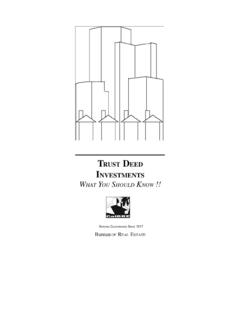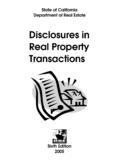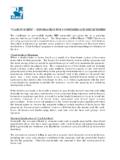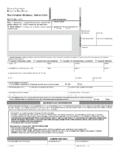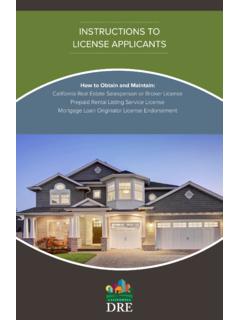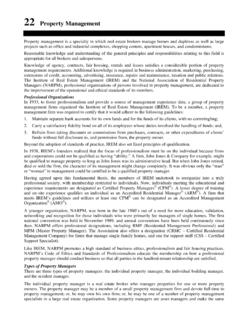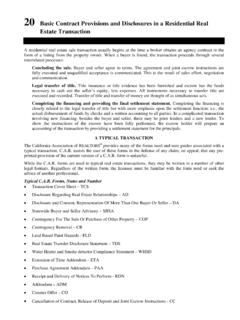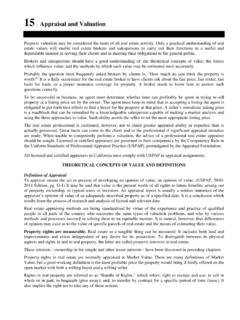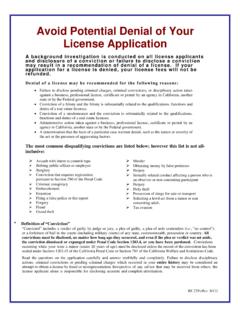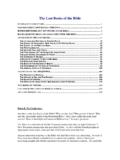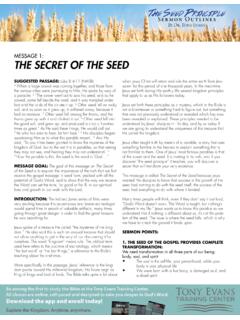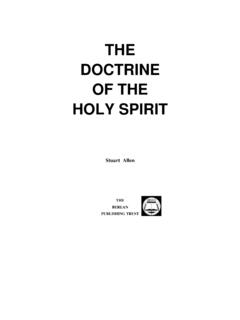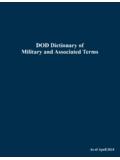Transcription of 5. Title to Real Property - California Department of Real ...
1 5 Title to Real Property In California , the basic principles followed governing Title to real Property were derived from England s Common Law generally implemented by case law known as stare decisis. This term is Latin for "to stand by a decision". Stare decisis is applied as a doctrine to bind a trial court by higher court decisions (appellate and supreme court) that become precedents on a legal question raised in the lower/trial court. Reliance on such precedents is required of lower/trial courts until a higher court changes the rule. California has a 150-year history of development and evolution in the way its courts have applied legal principles regarding the Title to real Property and the conveyance/transfer of the Title . These legal principles also apply to the encumbering of Title to real Property through mortgages or deeds of trust and to provide notice of and to evidence monetary claims against the Title in the form of liens.
2 This history is documented by the enactment of constitutional provisions and statutes and by a long line of case law. In the absence of some specifically applicable constitutional or statutory provisions, the Common Law/case law prevails. California ADOPTS A RECORDING SYSTEM California was admitted to the Union by the United States on September 9, 1850. One of the first acts of the Legislature of the new state was to adopt a recording system by which evidence of Title or interests in the Title could be collected and maintained in a convenient and safe public place. The purpose of establishing a recording system was to inform persons planning to purchase or otherwise deal with land about the ownership and condition of the Title . This system was designed to protect innocent lenders and purchasers against secret sales, transfers, or conveyances and from undisclosed encumbrances/liens.
3 The purpose of this system is to allow the Title to the real Property to be freely transferable. The California Legislature adopted a recording system modeled after the system established by the original American Colonies. It was strictly an American device for safeguarding the ownership of and the encumbering of land/ Property . Recording of sales, transfers, or conveyances and encumbrances/liens as part of a public record was established to impart constructive notice. This system of recording is known as the Race Recording , or as the Race-Notice Recording statute/law. Actual v. Constructive Notice Actual notice consists of express information of a fact. Constructive notice means notice given by the public records. By means of constructive notice, people are presumed to know the contents of recorded instruments. Publicly recording instruments of transfer/conveyance or to encumber/lien the Title to real Property imparts constructive notice.
4 For example, Civil Code Section 2934 enacted in 1872 states in part, Any assignment of a mortgage and any assignment of the beneficial interest under a deed of trust may be recorded, and from the time the same is filed for record operates as constructive notice of the contents thereof to all . Which Instruments May Be Recorded The Government Code of California provides that, after being acknowledged (executed in front of a Notary Public, or properly witnessed as provided by applicable law), any instrument or judgment affecting the Title to or possession of real Property may be recorded. See Government Code Sections 27201, , 27287, and 27288. The word instrument as defined in Section 27279(a) of the Government Code ..means a written paper signed by a person or persons transferring the Title to, or giving a lien on real Property , or giving a right to a debt or duty.
5 A similar definition is set forth in a historic 19th century case. See Hoag v Howard (1880) 55 Cal. 564-567. The definition of an instrument does not necessarily include every writing purporting to affect real Property . However, the term instrument does include, among others, deeds, mortgages, leases, land contracts, deeds of trust and agreements between or among landowners/ Property owners. Purpose of Recording Statutes The general purpose of recording statutes is to permit (rather than require) the recordation of any instrument which affects the Title to or possession of real Property , and to penalize the person who fails to take advantage of recording. CHAPTER FIVE 52 However, existing law includes examples where recording is required as a predicate to accomplish a defined public policy objective. One such example is Civil Code Section that provides, Where a power to sell real Property is given to a mortgagee, or other encumbrancer, in an instrument intended to secure the payment of money.
6 [T]the power of sale may be exercised by the assignee of the assignment if duly acknowledged and recorded (emphasis added). Another example is in Business and Professions Code Section regarding perfecting ownership of promissory notes or interests therein. This Section states in part ..the delivery, transfer and perfection shall be deemed complete even if the broker retains possession of the note or collateral instruments and documents, provided that the deed of trust or assignment of the deed of trust or collateral documents in favor of the lender or purchaser is recorded in the office of the county recorder in the county in which the security Property is located, and the note is made payable to the lender or is endorsed or assigned to the purchaser (emphasis added). Because of the recording of instruments of conveyance or encumbrance/lien, purchasers (and others dealing with Title to Property ) may in good faith discover and rely upon the ownership of Title or an interest therein.
7 While the Government Code does not specify any particular time within which an instrument must be recorded, priority of recordation will ordinarily determine the rights of the parties if there are conflicting claims to the same parcel of land/ Property , , the Title thereto or an interest therein. The instrument recorded first in the chain of Title would generally achieve priority over subsequently recorded instruments (fact issues such as subordination or actual notice may affect priority notwithstanding recording dates). The definition of the Race Recording or Race-Notice Recording statutes/laws is intended to describe the manner of achieving priority in the chain of Title . Generally, the person winning the race gains priority. The county recorder in the county within which the Property is located must record instruments affecting real Property . If the Property lies in more than one county, the instrument, or certified copy of the record, must be recorded in each county in which the Property is located in order to impart constructive notice in the respective counties.
8 If it is necessary to record a document written in a foreign language, the recorder will file the foreign language instrument with a certified translation. In those counties in which a photographic or electronic method of recording is employed, the foreign language instrument and the translation may be recorded and the original instrument returned to the party who requested recordation. See Government Code Section 27293. When an Instrument is Deemed Recorded Generally, an instrument is recorded when it is duly acknowledged or verified and deposited in the recorder s office with the proper officer and marked filed for record. It is the duty of the recorder to number the instrument in the order in which it is deposited, including the year, month, day, hour, and minute of its reception, and indicate at whose request it was filed for record. The contents of the document are transferred to its appropriate book or image of records upon the page or pursuant to the number endorsed on the document, and the original document is returned to the party who left it for recording.
9 The recorder indexes all recorded documents in alphabetical order according to the names of the grantors and grantees or mortgagors or mortgagees, which terms include holders of beneficial interests in and trustors/borrowers of deeds of trusts, and the name or nature of the document. The documents are also indexed by date of recording and the recording reference. See Government Code 27230 et seq. Effect of Recording as Imparting Notice The courts have ruled that the benefits of a recording statute are not available to one who takes Title with actual notice of a previously executed though unrecorded instrument. For example, possession of land/ Property by one other than the seller is actual notice to an intending buyer sufficient to impose a duty to inquire about the possession. Despite the recording statutes and the assurance they give about the status of Title , a prudent purchaser should inspect the premises in person or through a trusted agent.
10 The obligation to inspect includes inquiring of persons in possession of the real Property ( , a tenant or lessee), what claim such persons have to occupy and use the Property , and is there a written agreement supporting the claim. The agreement may be a month-to-month tenancy, a leasehold or an estate for years, a land contract of sale, an option to purchase, a lease with a first right of refusal, etc. Such a claim would be Title TO REAL Property 53imparted by actual notice because of the occupancy of the persons in possession. The agreement evidencing the claim need not be recorded to affect the Title to the real Property . In addition to the foregoing, there are many types of unrecorded interests that a prospective purchaser may discover during a physical inspection of Property . For example, a pathway or sewer line may mean adjoining owners have an unrecorded easement.

